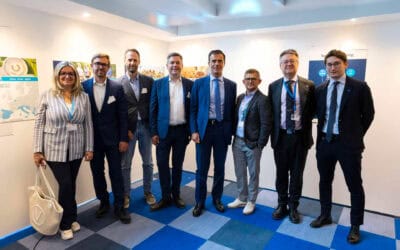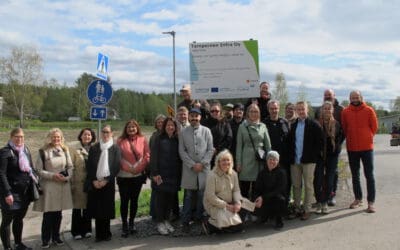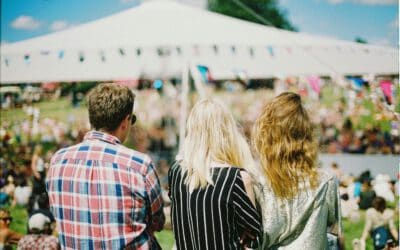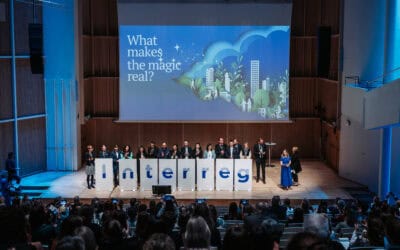
18 March 2024
I do believe in the power of Interreg!
Interview by Anna Gałyga
How do you see the role of Interreg within a wider context of the Cohesion Policy?
Interreg is one of the key instruments through which the Cohesion policy is implemented. Cooperation between countries and regions is at the heart of Interreg. Interreg is an unique instrument through which regions – including national, local and regional authorities – cooperate to reduce environmental, economic and social disparities between regions and join forces to resolve efficiently and more effectively issues of common interests. Interreg is a shared management programme meaning that once the legal framework is adopted by the European Commission, the Council and the European Parliament, it is the Member States participating in a programme who take the decisions on priorities, the measures required and the type of projects to receive funding to successfully implement the program and achieve the programme goals. There is no other instrument that empowers the Member States more. I think we do not reflect on this enough.
Interreg facilitates learning and exchange of best practices between regions. By facilitating networking and knowledge transfer, Interreg enables regions to benefit from each other’s experiences and expertise, hopefully leading to more effective policymaking and implementation.
By cooperating across borders, we spare resources and use them in a more efficient way. You don’t need to find the solution alone: you can share the resources, the knowledge and the experience with each other. And many unpredicted events requires joint actions as for example the COVID-pandemic, the energy crises and the ongoing war in Europe.
For me, Interreg is also a peace project. It promotes European solidarity. When you cooperate with other nations, you learn about different cultures. You build connections and friendships. It is also about building trust and a common future across the border regions. It is an essential tool for achieving balanced and sustainable development across the EU.
How do you think we could communicate the Interreg value added better?
Projects have to invest in communication activities and communication skills. They need to tailor communication messages to different target audiences, including the general public. Visual representations can help convey complex information in a more accessible and engaging manner such as infographics, videos, and interactive maps to illustrate the geographical scope and thematic focus of Interreg projects it is an examples.
It is vital to have skilled communication managers capable of articulating project narratives in a clear language that everyone understands, and most importantly what was the major challenge and how the Interreg project helped address it more successfully through cooperation. This is essential for engaging a broader audience and showcase the tangible benefits and outcomes of the EU Interreg projects and the value added of doing this through cooperation across the borders.
We should also be aware of the long term positive investment in engaging young people in Interreg cooperation. A good example is the Interreg Volunteer Youth (IVY) programme, which provides young people an opportunity to experience Interreg programmes, interregional cooperation and projects first-hand.
As desk officer for Interreg Baltic Sea Region, do you have any favourite memories or experiences?
For me, it was the very beginning of the programming period, when the Member States were debating the content and thematical priorities of the present Programme.
It was fascinating to follow the discussions: identifying areas of mutual interest, assessing development patterns and traps for such a wide geographical area, and the actual negotiations to identify the areas of common interests.
Project visits are inspiring too. I can witness what the Interreg projects has accomplish. I vividly recall when we visited the children’s hospital in Riga (as part of the KidsLikeUs project): I never thought that our projects can do so much for young people.
How do you see the future of Interreg then?
I do believe in the future of Interreg. I believe there will be more cooperation and more Interreg in the future but may be in a different and improved format. I believe that If we are to make Europe a better place to leave we cannot do it alone. I hope we can use 2024 to discuss, collect feedback from different stakeholders and design a powerful instrument which contributes to making Europe more greener, closing the gaps and regional disparities.
#DidYouKnow
Interreg Baltic Sea Region offers so much more than money; they bring together cultures, perspectives and expertise to get the best ideas and joint solutions for the Baltic Sea region. If you want to have your share in shaping the future of Interreg, join the online consultations.
More recent news
How transnational cooperation is building Europe´s future with youth
Explore how transnational cooperation is transforming Europe, from addressing climate change to fostering local economic growth. This exhibition highlights the powerful impact of collaboration beyond borders in shaping a stronger, more united future.
Painting Baltic Sea region cities blue
There is nothing more exciting than seeing an Interreg project in action. On 22 May 2025, the project City Blues showcased how it is changing areas around the city of Tampere to prepare it for the consequences of climate change better.
Overcoming Borders Together – Interreg at the Fehmarnbelt Days 2025
11 June 2025 Overcoming Borders Together – Interreg at the Fehmarnbelt Days 2025 Written by Anna ZaccaroJoin us at the Fehmarnbelt Days 2025 on June...
The magic of Interreg: this is how we do it transnationally!
Almost 300 guests, the charm of Finnish Tampere and a vibrant colour palette of transnational cooperation: the Interreg Baltic Sea Region Programme Conference held on 20-22 May 2025, brought to light the benefits of Interreg and the magic behind them.






